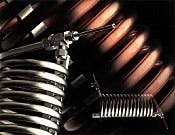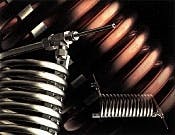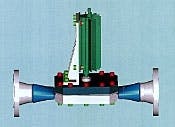Free ball valve catalog
A new catalog of corrosion-resistant, advanced composite ball valves is available, free for the request.
Catalog 200 describes a line of flanged, flangeless-wafer, threaded-end, and three-way ball valves. The new Phalanx automated valve for severe operating environments is featured along with actuators, on/off automated valves, and modulating control valves.
These advanced-composite ball valves are made of glass and graphite-fiber-reinforced high-performance resins. Hastelloy-C stems, encapsulated in the same advanced-composite materials, provide mechanical strength and corrosion resistance inside each valve.
Source: Nil-Cor Operations, Dresser Valve Div., Box 2058, Alliance, OH 44601.
Dual heat transfer coils
Problems typically encountered when obtaining samples from high-temperature, high-pressure fluid systems can be alleviated with this firm's new dual heat transfer coils.
These counterflow heat exchangers are designed and made to be efficient, durable, rugged, and resistant to operating in demanding environments-boiler steam, boiler feedwater, superheat steam, hot chemical solutions, and other process fluids.
Built with a tube-within-a-tube design that features heavy duty forged terminal fittings, coils allow the operator to withdraw uncontaminated samples of a process fluid for laboratory testing at room temperature. The coils can also be used in continuous sampling systems for on-line process control.
Coils come in copper or stainless steel and in other materials upon special request. Because coils are made with tube stub ends, the user can choose from a range of end connections.
Terminal fittings are designed to permit the inner tube to go through in one piece, like a thermocouple connection.
Pressure and temperature ratings of the coils conform to the applicable ASME Boiler Code allowable stress values.
A convenient two-hole mounting bracket permits the coil to be located near the point of measurement.
Source: Instrumentation Connectors Div., Parker Hannifin Corp., Box 400004, Huntsville, AL 35815-1504.
Geopressure analysis software updated
Version 7.0 of DrillWorks/PREDICT geopressure analysis software has incorporated time saving functions with improved user interface to enable oil and gas operators to quickly and accurately predict geopressures.
The new version includes integration with the firm's newest product DrillWorks/BASIN, a new addition to the company's family of pore pressure software. With DrillWorks/BASIN, the user can easily employ advanced basin modeling and data inversion techniques to predict geopressures at the basin scale in the planning phase of a well and update the prediction in real-time during drilling. BASIN also allows the user to develop a comprehensive data base for maintaining geopressure data for a basin.
Effective with the new release of the Office Version of the software is the ability to append well log data for effective analysis updates in the office while a well is being drilled. The user interface has been enhanced to allow the user to take advantage of dynamic track sizing, a scroll view, and a wizard interface. Users can now move backwards and forwards in a calculation as well as data import and export functions.
The output report facility has been enhanced to include the addition of user configurable reports. The Wellsite Version of PREDICT can now support sending WITS Levels 0, and data can be received and sent via FTP over an ethernet network or the internet, as well as over a modem.
Source: Knowledge Systems Inc., 11104 West Airport Blvd., Suite 215, Stafford, TX 77497.
Acoustic product de-emulsifies, degases crude
A new acoustic product de-emulsifies and degases crude oil. The patented in-line process promises to help reduce production cost when installed downstream from wells producing oil with a significant percentage of water, the company says.
a significant percentage of water, the company says.
The equipment drives high-pressure sound waves, at appropriate frequencies, into the crude oil flow stream.
In a test of a well producing heavy oil with a high solid content, where chemical separation techniques were being used, the acoustic technique reduced water content to 1%, with a 50% reduction in chemical feed, the company notes. The savings for the producer were estimated at $1.25 million/year, this firm says.
The new equipment can be installed directly in lines with sizes up to 4 in., and will operate continuously. The only consumable is electric power at 1 kw, so operating cost is minimal at $2.40/day, assuming an energy cost of $0.010/kw-hr.
This firm also employs its TERFENOL-D high power acoustic technology in several families of petroleum production products; including Powerwave for down hole production stimulation and ultrasonic equipment for viscosity reduction and well cleaning.
Source: Etrema Products Inc., 2500 North Loop Drive, Ames, IA 50010.




